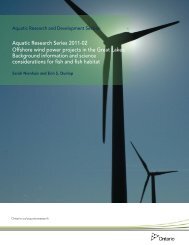Report of Research, Field Investigation and Survey of Robert D ...
Report of Research, Field Investigation and Survey of Robert D ...
Report of Research, Field Investigation and Survey of Robert D ...
You also want an ePaper? Increase the reach of your titles
YUMPU automatically turns print PDFs into web optimized ePapers that Google loves.
7 Concluding Comments<br />
My instructions from the <strong>Survey</strong>or General’s <strong>of</strong>fice were that the two Road Allowances are to be<br />
extended northerly <strong>and</strong> westerly, following the methods from the <strong>Survey</strong>s Act. I have not been<br />
able to find Case Law which contradicts this approach, although two Boundaries Act<br />
applications have bent Road Allowances <strong>and</strong> used perpendicular lines following Paul v. Bates.<br />
Boundaries Act cases are not considered legal precedent setting, even according to the Deputy<br />
Director with the Regulatory Services Branch <strong>of</strong> Service Ontario. The issue <strong>of</strong> bending a lot or<br />
concession line has simply not been discussed by any <strong>of</strong> the numerous legal decisions I have<br />
referred to.<br />
There are four Alberta cases which have held that accretion ends at ‘ATS’ lines (township lot<br />
fabric), although it isn’t clear whether these lines were side lines or ‘front ‘lines in all cases.<br />
There is a sketch with Andriet which seems to indicate that the ATS sideline was also respected.<br />
Clearly in Johnson v. Alberta, the Court placed a high status on the ATS lines, regardless <strong>of</strong><br />
whether they had previously been surveyed or not.<br />
In his document <strong>of</strong> additional information for the Deputy Director in Boundaries Act File B-<br />
1212, Ron Stewart O.L.S. claims that underlying geographics (lot lines) are extinguished when<br />
water levels increase <strong>and</strong> then recede at a later date. O.L.S. Stewart claims that Volcanic Oil<br />
<strong>and</strong> Gas v. Chaplin determined that once up-l<strong>and</strong> becomes part <strong>of</strong> the bed <strong>of</strong> the lake <strong>and</strong> then<br />
re-appears the pre-existing boundaries disappear, <strong>and</strong> that once this happens, the accreted l<strong>and</strong>s<br />
should then be distributed according to Paul v. Bates rather than the <strong>Survey</strong>s Act. I do not see<br />
this from my reading <strong>of</strong> the case, since I tend to focus on the facts <strong>of</strong> the case <strong>and</strong> what is<br />
actually written by the court, rather than trying to read behind the lines. This issue may<br />
ultimately need to be determined through a judicial review. Given the lack <strong>of</strong> legal support for<br />
bending original Township fabric, as compared to the certainty <strong>of</strong> the instructions for how to<br />
proceed contained in the <strong>Survey</strong>s Act I believe we have good reasons for using the <strong>Survey</strong>s Act<br />
methods.<br />
Johnson v. Alberta, <strong>and</strong> to a lesser extent Pitt v. Red Deer, Andriet v. Strathcona No. 20 <strong>and</strong><br />
Lack v. Alberta all support the relatively higher status <strong>of</strong> ATS lines, which I would equate with<br />
Ontario’s lot <strong>and</strong> concession lines. In both cases there are clear statutory instructions for how<br />
such a line should be run, unless better evidence is available. In Johnson especially, the trial<br />
judge ruled that deviating from the ATS lines would give the plaintiff l<strong>and</strong> they were never<br />
intended to have, <strong>and</strong> that whether or not a line had actually been surveyed, the methods under<br />
the <strong>Survey</strong>s Act gave clear instructions for how they could be determined. It seems to me that<br />
given the authority the Minister has under the <strong>Survey</strong>s Act (as delegated), as recognized by<br />
Dennison v. Chew <strong>and</strong> by Zone v. McDowell, <strong>and</strong> given the clear method for setting these Road<br />
Allowance boundaries (as compared to the lack <strong>of</strong> clear direction from specific legal decisions),<br />
it is appropriate to use the <strong>Survey</strong>s Act method I explain under Section 6.1.2.<br />
Page 64 <strong>of</strong> 66
















